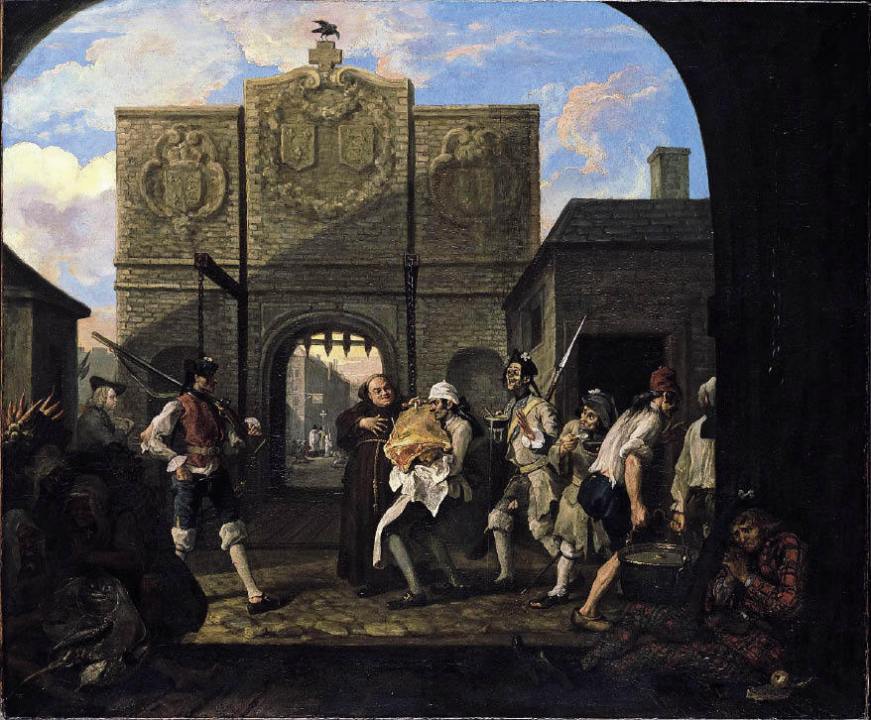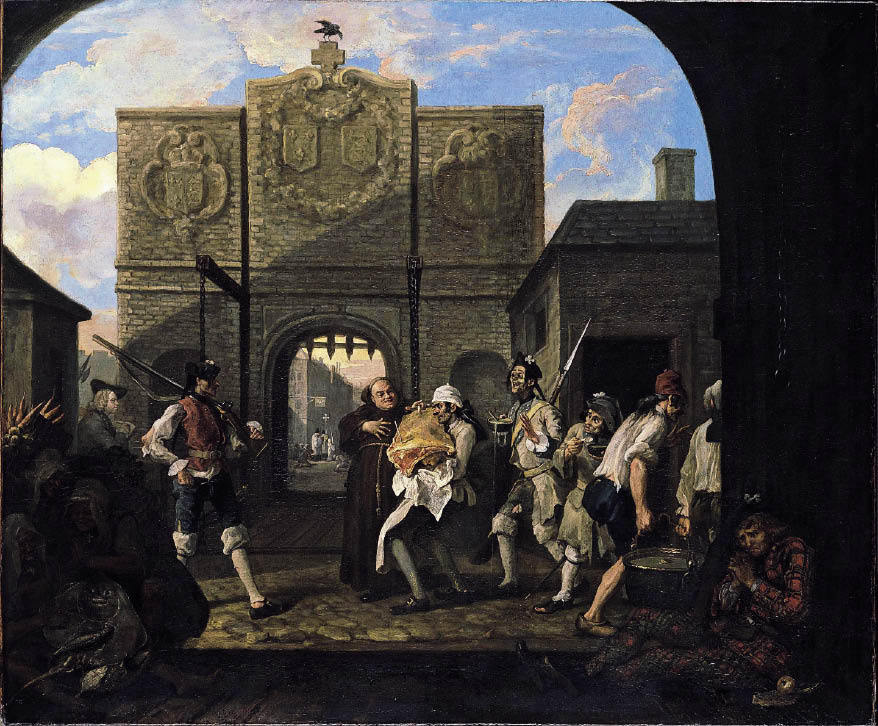Rude Britannia: British Comic Art
Tate Britain, until 5 September
If each age gets the art it deserves, it might also be said that each age gets the exhibitions it deserves. The robust tradition of British Comic Art has never looked so unfunny and anaemic as it does in this current overworked examination at Tate Millbank. My visit coincided with some voluble OAPs up from the country, a know-it-all guide manqué and a couple of solemn Americans who were evidently seeking enlightenment as to the strange habits of this island race. There were sighs aplenty but I’d reached Room 3 before I heard a single laugh, and this response was directed (not surprisingly) at a video screen and headphones replaying old episodes of Spitting Image. The problem is that if humour has to be explained, it very often ceases to be funny. And nowadays, curators nearly always get wrong what should be explained and what shouldn’t.
The first room is supposed to function as an introduction to the subject, and in this role it mixes the historical with the contemporary — Hogarth with Klega, H.M. Bateman with Wenceslaus Hollar, Rowlandson with Glen Baxter and Leo Baxendale of the Beano. There are some fine things here, as well as some dull ones, but the audience closely resembled Thomas Patch’s ‘Gathering of Dilettanti in a Sculpture Hall’ — the common lack of interest was all too evident. I liked the juxtaposition of Carole Windham’s ceramic figure group ‘Obadiah, Mastrr of Bursley’ (2000), with its 19th-century Staffordshire bull-baiting prototype. (At least the little dog laughed.) And hanging Gillray next to Donald Parsnips’s Daily Journal news-stand was an inspired move. Then there’s the wonderfully unfunny ‘Laughing Parson’ (inevitably reading Punch) by Charles Spencelayh, and cabinets of illustrations by Leech and Tenniel. But it doesn’t add up, and there’s no curatorial attempt at cohesion.
But in room two, the other extreme is reached and swiftly found as wanting. Here a series of supposedly witty but excruciating captions from Viz’s character Roger Mellie (‘The Man on the Telly’) offers a limping commentary on Hogarth’s famous print sequence, ‘A Rake’s Progress’. As a joke it backfires seriously. Hogarth, who made great art, deserves to be seen unmediated by such triviality. If you can ignore the intrusive captions, enjoy the potent Rowlandsons and a marvellous series of increasingly elaborate and surreal-looking 18th-century head-dresses, depicted by the likes of Philip Dawe and Samuel Hieronymus Grimm.
The next subject to take the organisers’ attention is politics, treated in an equally crass way in room 3. Here we encounter such giants of caricature as Ralph Steadman, intent on portraying politicians by their legs only, Gerald Scarfe, Steve Bell, a solitary Max Beerbohm, and off to the side is a sitting room where you can take your ease — should this fatuous exhibition have exhausted you prematurely — and chat or look at books. Room 4 is supposedly devoted to the bawdy but, after a good start with the saucy seaside postcards of Donald McGill, it declines through Beryl Cook to Carry On Up the Khyber dubbed with Gujurati obscenities. Somehow I don’t think Bernard Bresslaw and Kenneth Williams would see the funny side of that. Enough. The exhibition peters out via Cruikshank’s ambitious painting ‘The Worship of Bacchus’ — totally out of place here — and a room of mostly tedious absurdities.
It’s a serious business, humour. It must be — it’s even got to the press release. The best line in that handout reads: ‘Is satire truly effective as a means of political messaging?’ Don’t make me laugh. Please. And that’s another problem: this exhibition isn’t sure whether it should be itemising the mockery or decoding the wit. So it falls between two stools — not a pretty position for a show that deals so extensively in the scatological. There’s a handsome softback catalogue (price £17.99) if you want to examine the curators’ take on the subject any further, and a charming mouse-inflected gallery guide (free on entry) with drawings by Simone Lia. Neither dispel the tiresomeness of this exhibition. Seldom have I felt more in need of a good laugh.
Instead, this being the Tate, the first thing the visitor exiting Rude Britannia encounters is high art, or at least a contemporary version of it. The dramatic installation by Fiona Banner of real fighter planes in the Duveen Galleries is the crowd-puller the comic art show should be but isn’t. People are quite evidently fascinated by the proximity and undignified positions of these planes, not crashed but informally and absurdly placed: the grey Sea Harrier suspended by its tail, with its nose to the deck like a gutted fish, and the shining silvery Sepecat Jaguar upside-down on the floor, leaning on one wing. Its reflective surfaces are proving irresistible to the public — people are posing for all sorts of candid camera shots. The heroic has been subverted, the wings of war clipped and turned into art. But what beautiful objects these machines remain, resembling not so much birds or cats as sharks.
After the disappointment of Rude Britannia, the planes begin a process of lifting the spirits completed in Room 23, a gallery just off the Duveen. Here is a celebration of Gillian Ayres’s 80th birthday, in the form of a display given over entirely to her work. She generally works on a large scale, so there are only three paintings hanging, but what richness is encompassed in this trio. The first painting to fill the eye is ‘Phaethon’ from 1990, a grand horizontal canvas filled with vigorous red and yellow shapes, stacked and bursting from a just-suggested lunette form, which could also stand for the dome of the sky. Opposite is a more recent painting ‘Sang the Sun in Flight’ (2009), continuing the celestial theme in Ayres’s more boldly patterned late style, with the extended leaf and pod shapes of electric growth replacing the more compact textures of ‘Phaethon’. By way of contrast, and to provide historical context, the third painting is an early work, entitled ‘Break-Off’ (1961). It is less immediately recognisable as being by Ayres, having more in common with those artists (the European tachistes, the American Abstract Expressionists) who created the mood and moment in which it was made. It is rather beautifully and loosely painted, allowing lots of blank canvas (or just faintly colour-spattered canvas) in the intervals between elements. These are various lyrically brushed shapes based on the circle and the rectangle, adumbrated along its impurely cream length. It is oddly uplifting and beguiling, and totally unprecious, like all Ayres’s work. I left the Tate with my belief in humanity restored.







Comments